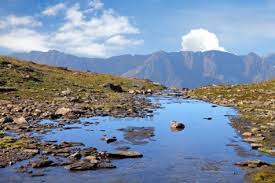| Home » Articles » LESSON NOTES (Social Studies) » High School level |
Rocks of the earth
ROCKS OF THE EARTH:  The earth’s crust consists of rocks and rocks consist of combination of different minerals and in turn minerals are made up of one or more element, some minerals are themselves elements, example Gold, Diamond, Sulphur we don’t have combination of these elements.
Definition: Rocks are aggregate of minerals in solid state.
Rocks can be classified according to their origin and age, there are three types of rocks which classified based on their mode of formation.
TYPES OF ROCKS
1. Igneous rocks
2. Sedimentary rocks
3. Metamorphic rocks
1. Igneous rocks
The name igneous is a Latin word which means fire. This types of rocks also known as mother of rocks when molten rocks called magma cools and solidifies either within or outside the earth’s surface. These types of rocks are categorized in two types.
TWO CATEGORIES OF IGNEOUS ROCKS
1. Intrusive igneous rocks, these are type of igneous rocks that formed when magma cools and solidifies deeply inside the earth. In this magma cools very slowly hence the rocks formed tend to have large crystals, these also are categorized into two types that are Plutonic & Hypabyssal, Plutonic are those formed very deep while hypabyssal are those formed near the extrusive igneous rocks, example of these rocks are Granite, Diorite, Gabro etc.
2. Extrusive igneous rocks (volcanic): This is formed when magma cools and solidifies above the earth’s surface, lava solidifies very quickly hence the crystals formed are very small, example of these rocks are Basalt, Rhyolite, Andasittle, Obsidian.
CHARACTERISTICS OF IGNEOUS ROCKS
1. They are crystalline
2. They have no laid in layer
3. They do not contain fossils
4. They are hard rocks
Igneous intrusive features are Dyke, Sill, Laccolith, Batholith, lapolith etc.
SEDIMENTARY ROCKS
These are rocks formed by the deposition of eroded rock materials carried by river, wind, moving ice, ocean currents and drifts, they are the result of continued accumulation, compaction and sedimentary of sediments. The most common rocks of these deposit in water. There are three types of sedimentary rocks.
THREE TYPES OF SEDIMENTARY ROCKS
1. Organically Formed sedimentary rocks, These are the type of sedimentary rocks that formed from organic material, remains of small creatures, particularly shells may be deposited together and after a long time become compact to form Sedimentary rocks. Examples of such rocks are Limestone, Chalks, Coal and Coral reef.
2. Mechanically formed sedimentary rocks, these are rocks that have been formed by compaction and cementation of sediments. Example of these rocks are sandstone, Mud stone, coral reef etc.
3. Chemically formed sedimentary formed, these are formed through chemical precipitation, some water contain salt in solution, when water evaporates beds of these are left behind, these types of rocks are such as Gypsum, Dolomite, Potash, titrates etc.
CHARACTERISTICS OF SEDIMENTARY ROCKS
1. They are stratified i.e. they laid down in layer
2. They contain fossils
3. Are non-crystalline
METAMORPHIC ROCKS
When igneous rocks and sedimentary rocks are subjected to great heat and pressure they change their physical and chemical properties and then metamorphic rocks are formed. Metamorphic derived from the Greek word which means changing form.
KINDS OF METAMOPHIC ROCKS
1. Dynamic metamorphic rocks are kind of metamorphic rocks that formed by compressional forces which cause the earth movement and bring about mountain building. These rocks are changed in their physical appearance and character.
2. Thermal Metamorphic rocks, the rocks may change their physical due to contact of rocks with hot molten volcanic magma as it pushes them. Then the rocks formed after being changed by this process are called Thermal Metamorphic rocks.
3. Thermal-metamorphic rocks, these are the rocked formed by combination of heat and pressure.
CHARACTERISTICS OF METAMOPHIC ROCKS
i. They are compact and resistant to erosion
ii. Do not contain fossils.
ECONOMIC IMPORTANCE OF ROCKS
1. Formation of soil
Soil is formed from rock, the fertile volcanic soil which is widespread in central
2. Fuel
Some rocks have been changed into substance which can be used for fuel, example Coal in Mbeya, Tanzania.
3. Building Materials
Some rocks are used as building materials. | |
| Views: 4387 | |
| Total comments: 0 | |